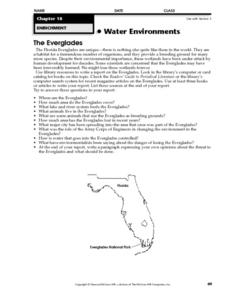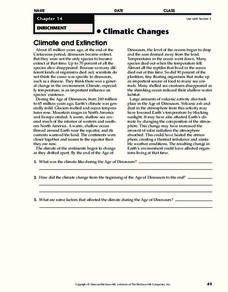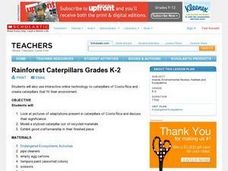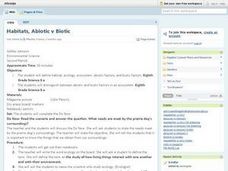Curated OER
Know It All: Seals! Teaching Plan
Young scholars discover information about seals, including behavior and habitat. For this early childhood lesson plan, students identify various aspects about seals. Young scholars create an illustration or painting of their favorite...
Curated OER
Biodiversity
In this biodiversity worksheet, students sort and classify animals by their observable features using a dichotomous key. Students then respond to questions about complete and incomplete metamorphosis.
Curated OER
Lake Word Search
In this lake word search, students find 13 different vocabulary words associated with lakes such as habitat, oxygen, pollution, invertebrates, and turbidity.
Curated OER
Animal Research
In this animals worksheet, students complete a graphic organizer by choosing an animal and then researching information such as anatomy, diet, enemies, habitat, and reproduction.
Curated OER
Relationships Among Living Things
For this relationships among living things worksheet, students determine if given statements are true or false. Students correct the false statements making them true. Also, students answer several short questions that relates to...
Curated OER
Relationships Among Living Things
For this living things worksheet, students review terms and concepts about the different relationships between living things. This worksheet has 7 true or false and 5 short answer questions.
Curated OER
Everglades
For this wetlands worksheet, students will research and answer 11 questions about the Florida Everglades. Students will create a report.
Curated OER
Climatic Changes
In this weather activity, learners read an excerpt describing the climate and extinction. Then they explain what the climate was like during the Age of Dinosaurs. Students also determine some factors that affected the climate during this...
Curated OER
The Excretory System
In this excretory system worksheet, students read a brief excerpt about water balance and the excretory system. Then they identify what compound birds, insects and reptiles living in dry habitats excrete. Students also describe how...
Curated OER
Butterfly Report
In this biology worksheet, learners draw or trace an accurate picture of a butterfly. Then they complete the information related to their butterfly's classification and list the habitats where they are likely to be found. Students also...
Curated OER
Adopt-An-Insect II
In this biology worksheet, learners adopt an insect of their choice and draw a diagram of their insect, labeling the major body parts. Then they describe where their insect can be found and what they eat.
Curated OER
Butterfly Report
In this biology instructional activity, students write an insect report about the butterfly, giving its common and scientific name. Then they describe the butterfly habitats and winter plans. Students also describe three interesting...
Curated OER
Stack #84200 Word Search
In this science instructional activity, students locate and identify various vocabulary terms related to earth science and biology. There are 12 words located in the puzzle to find.
Curated OER
Ecology and the Ecosystem
In this science activity, students locate 20 terms about the ecosystem in a word search. Answers are available in various formats.
Curated OER
Water: H2O = Life
In this earth science worksheet, pupils explore and describe animals and their adaptations, including their habitats, physical characteristics, and competing organisms. They also explore and describe how others use water around the...
Curated OER
Book Making
Students make connections with real life experiences and the two languages, including Spanish and English. They create their own books in this project lesson plan to take home and read with their families. Students also use a digital...
Curated OER
Bivalve or Univalve (Clam or Snail)?
Fourth graders explore the meaning of the prefixes "bi" and "uni." In groups, 4th graders observe pictures of shells and handle real shells. Students create a chart to classify each shell as a bivalve or univalve. They identify the...
Curated OER
Bivalve Biology
Young scholars place clams into a beaker containing saltwater. They place a small drop of food coloring just above the shell. Students observe the movement of the food coloring. Clams are then placed into clean beakers of saltwater with...
Curated OER
What's That? A Habitat!
Students identify and define what oceans, deserts, woodlands, and cold places are. Then they identify animals that live in different habitats by playing a hands-on sorting activity. Students also research various web sites as instructed...
Curated OER
Rainforest Caterpillars Grades K-2
Students are told that after they discuss and examine of rainforest caterpillars, they are going to create their own rainforest caterpillar based on the information they have studied. They are given the habitat scenarios on 3x5 cards.
Curated OER
Pond Water
Pupils explore a creek environment. They make observations, identify the living and nonliving factors in the environment and collect a plankton sample to take back to the classroom. In addition, they look at plankton under a microscope.
Curated OER
Adaptations
Students identify what adaptation is and to research a specific mollusk. They also identify and interpret how animals get their common and scientific name and why it is Latin. Finally, students draw their shell (mollusk) and name their...
Curated OER
A Habitat Is Home
Students are introduced to the concept and components of a habitat. They discuss the key components of a habitat and describe how certain factors can cause disturbances in a habitat and change its population. Activities are leveled...
Curated OER
Habitats, Abiotic v. Biotic
Students explore and define ecosystem, ecology and habitat. They discuss abiotic and biotic organisms and the things needed for survival. After observing pictures of animals in their habitat, students compare and contrast habitats and...

























